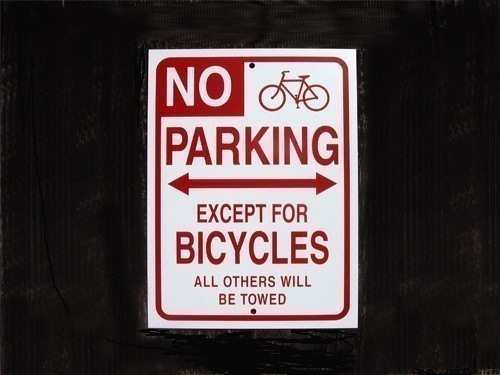
Just as railroad tracks have always belonged to trains, roads have always belonged to cars. Their purpose was to create a level, smooth surface ideal for operating motorized rolling vehicles. Thick black tires glided over newly paved roads, almost effortlessly, until the ravages of time, weight and abuse caused cracks and fissures and potholes. Then, the roads became treacherous for the machines they sought to accommodate.
Around this cult of the car an entire system evolved. All forms of parking had to be installed or built. Parking lots were painted with rows of car length lines demarcating the area of space allocated for each car. Entire structures were erected for the sole purpose of temporarily housing cars while their owners engaged in activities away from home.
Many stories high, these concrete monstrosities could be recognized from afar. They sprung from the ground as grotesque, architecturally deprived boxes with slits along their exterior walls where cars could be seen traveling from level to level. At that point, cars were no longer relegated to the outdoors.
Buildings were designated for cars to use. Drivers could avoid weathering the elements since they could drive their cars indoors. The idea of protecting cars from rain, snow and vandalism became the province of the wealthy who could afford indoor accommodations for their vehicles.
Still, the parking lots and towering parking garages weren’t enough. Drivers needed convenience. That was the whole point of owning a car. So, the parking concept spread like wildfire to include curbside parking spots and an assorted variety of on-street parking spaces.
Nowhere was safe from the growing automobile parking agenda. Cities became battlegrounds of parking mayhem. Angry cries of unfairness rang out between the honking of horns, squealing of tires, and screeching last-minute braking. The wasted hours of circling around city blocks in search of a free parking space brought drivers to blows over who had arrived at the space first.
Violence was a last resort, but for many it became a necessity because driving can lead one to his destination with no place to leave his car. For drivers, there is nothing worse than getting where they were going, with no way to stay. In such cases, the car, symbol of freedom that it is supposed to be, is an impediment to residing in certain locations.
Some places, due to the scarcity of parking were now off-limits to cars. One would think that this would cause a shift towards adopting other forms of transportation. Yet, instead, it caused the creation of plans to build more parking — even if it meant paving over the last remaining stretch of open space — because drivers could not conceive of going somewhere without their cars. They felt it was a right to travel everywhere by car so cities were forced to eek out every last parking space they could fit in to the landscape.
Virtually everyone alive today grew up in such a world. Those who knew a different world — a pre-car-centric world — have long since gone, taking with them a time when motors were unnecessary for travel.
Imagine a world where cars neither went indoors nor lined the streets, a world where other smaller, quieter vehicles dominated inhabited spaces. It would be a world with much more open space. The same cities and towns would have more breathing room for their inhabitants.
An average car is 13.5 feet long. If we lined up 100 cars back-to-back, they would take up a quarter of a mile. 1000 cars would take up 2.5 miles. The average bicycle, on the other hand, is approximately 70 inches, or 5.8 feet in length. 100 bicycles lined up back-to-back would take up just over a mile.
If we put those vehicles side-by-side, we would discover another huge size difference. The average car is 6 feet wide; the average bicycle is about 2 feet wide (at the handlebars, taking into consideration the average widths of road bikes and flat bar bikes). In essence, cars are several times longer and several times wider than bicycles.
As the world’s population grows, space, particularly in urban areas, will become more scarce. In just the last 50 years, the global population has soared from approximately 3 million to 7 million. Modernity means access to cars. And, the more people we have living on the planet, the more cars we will have.
Encouraging bicycle use isn’t just about health or pollution, it’s about conserving space. The majority of space on our planet should be reserved for humans, not machines. Freeing up space by reducing the number of cars will create more breathing room for everyone. To create more livable cities we need to reverse the importance of vehicles and post more signs saying: “No parking, except for bicycles; all others will be towed.”



